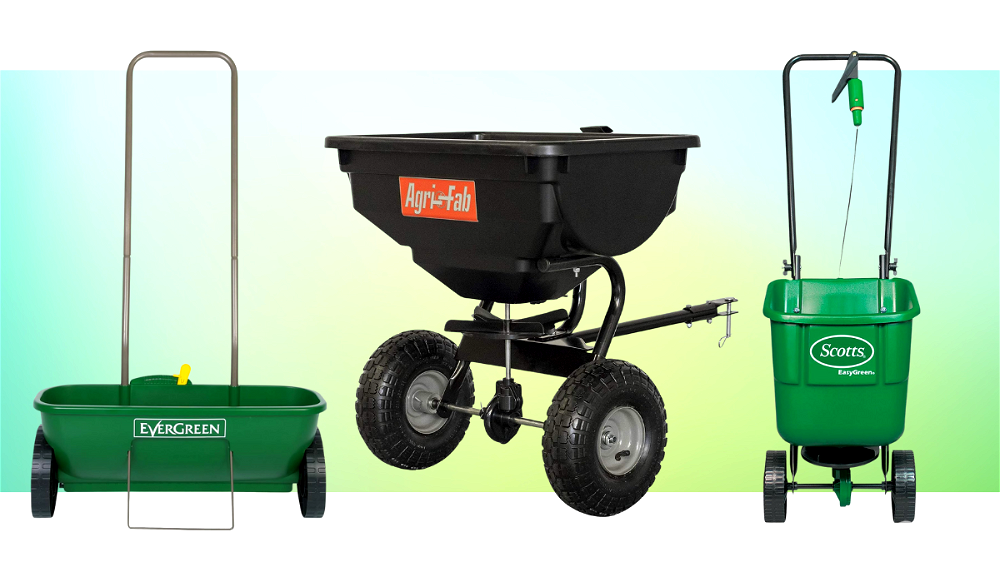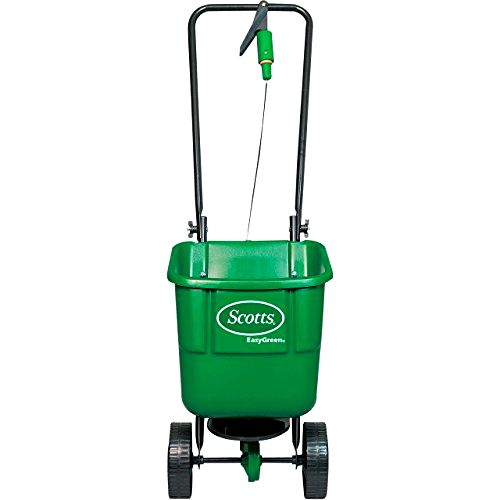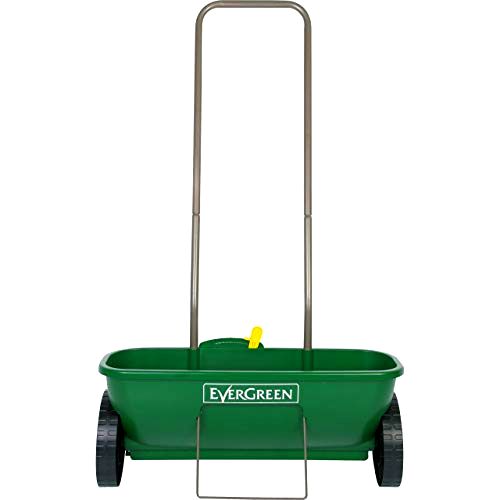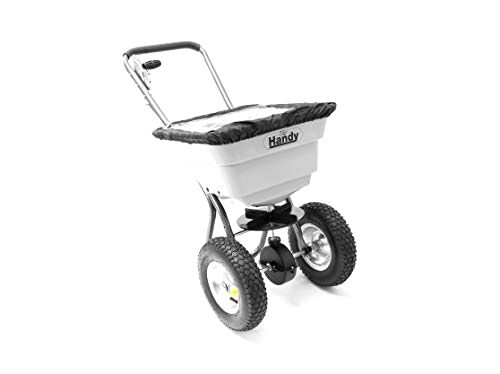Read Reviews
The Best Lawn Spreaders

-
Best lawn spreader overall - Scotts EasyGreen Rotary Spreader
-
Best for small gardens - EverGreen Easy Spreader Plus
-
Best heavy duty lawn spreader - Agri-Fab 38.5kg Towed Spreader
-
Best for rainy weather - Handy 80lb Wheeled Lawn Spreader
Lawn Spreader Reviews
1. Scotts EasyGreen Rotary Spreader[ SAVE 3% ]
Best lawn spreader overall
- If kept dry, this spreader is easy to clean
- Folds up after use for easy storage
- The grass seed/fertiliser is visible while you are spreading, so you’ll know the second it needs topping up
- The spread width can be adjusted up to 3.4 m which allows you to get around bigger gardens much quicker
- The hopper base is a flat square so it needs to be tipped from side to side to get the last of the product onto the spreader wheel
- The dial that sets the spread rate may alter as you walk around
- Finding the right pace for optimum product distribution may be tricky - easy to go too fast or slow
- May clog if used on a damp day
- Spreading Width
- 3.4m
- Weight
- 3.4 kg
- Design
- 4.5
- Ease of Use
- 4.7
- Value for Money
- 4.5
There’s a tricky balance to be met when it comes to gardening tools: we want machines that will do a good job, without forking out professional prices unnecessarily.
Fortunately, Evergreen’s Scotts EasyGreen Rotary Spreader strikes a good compromise between practicality and affordability.
This reasonably-priced rotary spreader offers quite a lot of features, especially compared to other lawn spreaders at the same price-point, and it also works reliably.
When used with either fertiliser or grass seed, it spreads the particles evenly over the area, dramatically improving results compared to doing the job by hand. It’s a good choice for medium-sized lawns.
There are a couple of “learning curves” that need to be addressed, but after a bit of practise, this lawn spreader becomes easy to use. Firstly, it can be initially difficult to work out which settings are needed to achieve a particular spread rate. Given that this is important for both lawn feed and seed, some trial and error is required. Secondly, the ideal walking pace also needs to be deduced by testing a few speeds.
However, what this ultimately means is that there are plenty of settings to choose from – you just need to get the hang of them, There are various apertures as well as a wide spreading width that’s adjustable between 1.2 m and 3.4 m.
As a result, this lawn spreader is versatile to use with a lot of different lawn products, and for a variety of uses too.
This spreader weighs 3.4 kg when empty and can get significantly heavier depending on how much product you put inside. The plastic hopper is quite large, meaning it has a decent capacity, and thanks to the wide dispensing holes, the product rarely gets stuck on dry days. Cleaning the drum after use is vital, as any remaining particles can solidify and clog the machine.
The adjustable handlebar can be lengthened to reduce back strain, and it also folds down so that the whole unit becomes much more compact for storage.
In terms of weather, this spreader is best used when it’s not raining – any dampness can cause grass seed or fertiliser to stick together and this can cause the machine to jam. Of course, this is slightly impractical for applying fertiliser that needs to be watered in, as it can be nicer to put this down when it’s raining. However, with this spreader, you’ll just have to apply it on a dry day and water afterwards.
Overall, this is is one of the best lawn spreaders for versatility, quality and affordability – it’s a decent size, with plenty of adjustability and it won’t break the bank. The only downside is needing patience to work out all the spread rate settings.
Did you find this review helpful?
2. EverGreen Easy Spreader Plus
Best for small gardens
- The included stand holds it upright while you fill it to reduce wastage
- If used correctly, this spreader provides an even coverage
- Most users found this very simple assemble in just a few minutes
- Lightweight so easy for small users to push
- Robust and long lasting build
- Bulky and not easy to dismantle for storage in tight spaces
- Continues dispensing as you turn corners, so you’ll need to stop the flow of product if you want to turn around
- It may be difficult to stop the flow which can lead to dropping excess product onto your lawn
- Spreading Width
- 0.53m
- Weight
- 1.97 kg
- Design
- 4.4
- Ease of Use
- 4.6
- Value for Money
- 4.4
The EverGreen Easy Spreader Plus does a good job of living up to that ‘easy spreader’ name – it’s an uncomplicated drop spreader with a basic design that works well. It’s a simple but effective way to spread seed and fertiliser in small gardens.
It may not be quite as sophisticated as a rotary spreader, but it does keep everything under control.
Whilst rotary spreaders can be prone to flinging grass seed everywhere, including into flowerbeds, this EverGreen Easy Spreader Plus is a drop spreader that only dispenses seed, or fertiliser, under the unit as you walk (so you won’t find yourself pulling unwanted grass shoots out of the flowerbed a week later!).
It has a max spread width of 0.53 m, so achieves an accurate application and everything is kept firmly under control. However, because of this, it may be a better choice for smaller lawns, or perhaps medium spaces, rather than large areas.
When it comes to setting the distribution rate, the process is very straight forward. The spread rate can be adjusted using the yellow indicator that’s positioned by the hopper – it clearly states which setting is selected and takes a lot of the guesswork out of product spreading.
Walking at a fairly spritely pace of 1 metre per second seems to be considered the optimal, so you can consider this your cardio workout for the day as well.
Whilst not overly large, measuring approximately 30 cm wide, the EverGreen Easy Spreader doesn’t condense down particularly well for storage, so it does take up a fair amount of space. The handle can detach, but the wheels are very difficult to remove, so it’s hard to pack away into it’s original box.
The main thing to watch out for are corners – it can be easy to accidentally distribute too much product. The drop spreader is not easy to ‘turn off’ at a corner because the aperture only closes when the yellow indicator is pointing to ‘0’. This is difficult to change whilst in the middle of distributing product.
Therefore, keeping moving is the aim of the game in order to stop excessive product being dropped on corners or at the start/end of a run.
All things considered, this is one of the best lawn spreaders if you would prefer to use a drop spreader over a rotary spreader. It won’t fling grass seed into the flowerbeds and is easy to control, plus it has clear settings to help achieve an even distribution.
Did you find this review helpful?
3. Agri-Fab 38.5kg Towed Spreader
Best heavy duty lawn spreader
- Easy to use and spreads evenly
- A reliable budget option for larger outdoor areas
- Best for pellets as opposed to fine granules
- Easy to hook up to your mower or tractor
- While not hard to build, some users found the assembly instructions to be unclear
- Some users commented that the flow volume control is ineffective
- Bottom of the hopper is flat which makes it hard to spread the last of the product
- It can be difficult to open the dispensing hatch from the driver's seat of the tractor/mower
- Spreading Width
- 3m
- Weight
- 8.2 kg
- Design
- 4.4
- Ease of Use
- 4.5
- Value for Money
- 4
For orchards, paddocks, fields, or large (and I mean large) gardens, you can’t be wasting time with a push-along spreader. There are some spaces which require professional-level kit, and that’s where the towable Agri-Fab 38.5kg Towed Spreader comes in.
It has a 38.5 kg capacity, so we’re not talking about your standard gardening tool here… the unit gets hooked up to a ride-on mower or tractor, and can cover approximately 1300 m² (that’s about ¼ of an acre) before needing to be refilled.
If you’re working on a large scale, you’ll be able to fit roughly a 20 kg bag of fertiliser or lawn seed into the hopper at a time.
This large lawn spreader arrives entirely flat-packed, and goes together easily with the help of relatively clear diagrams, although they can be a bit small in places. With two 25 cm-wide pneumatic tyres, a metal frame and a plastic hopper this joins together to be a pretty sturdy unit that copes well being towed.
In terms of performance, this spreader is very efficient at spreading lawn products such as fertiliser or grass seed across large areas. Thanks to its large wheels, it moves well, although it may jump over uneven ground. At 38.5 kg, it’s still quite light for a towable unit. The drop-spreader hatch may also need double checking occasionally – sometimes it toggles itself closed as it goes.
One thing to bear in mind is that this is a drop lawn spreader, which means that it starts dispensing as soon as the hatch is open. Therefore, it’s necessary to get a bit of a move on between opening the hatch and getting your tow-vehicle moving, otherwise too much product will be deposited in one stationary place.
Due to the design and simplicity of this lawn spreader, it’s a great option for large spaces. As long as you have a way to tow it, it’ll offer an easy, straight forward way to cover a lot of area without being too expensive.
Did you find this review helpful?
4. Handy 80lb Wheeled Lawn Spreader
Best for rainy weather
- Easy to push on most terrains thanks to the 28 cm pneumatic tyres
- A great value option for large areas and lawns
- Sturdy, durable build that should last year after year
- Comes with a covered lid so can also be used on wet/damp daus
- Some users report it being difficult to accurately control the spread
- Many users found the build instructions aren't sufficiently informative
- Setting the feed rate takes time and is a bit tricky
- Spreading Width
- 3.66m
- Weight
- 12.3 kg
- Design
- 4.4
- Ease of Use
- 4.4
- Value for Money
- 4.2
If you’ve been previously jilted by trying to use a lawn seed spreader in the rain, only to find it blocked with soggy fertiliser or grass seeds, this Handy 80lb Wheeled Lawn Spreader offers a great solution to wet-weather work, coming with a removeable cover.
As we all know, here in the UK it’s pretty impossible to rely on a dry spell, so waiting for one to come around in order to apply fertiliser is pretty unrealistic. Keeping the product dry by covering the hopper is a simple yet effective solution, making this ‘Handy’ model the best lawn spreader to use in bad weather.
Even with the cover in place, it’s still possible to keep an eye on how much product is left, because the transparent material provides a window into the hopper – so, overall, there’s a definite sensation that the designers of this large lawn spreader had first-hand experience using these kinds of tools.
It has large pneumatic tyres that are 28-cm wide; these should be less prone to leaving tracks in the lawn compared to thinner wheels, even the lawn spreader is filled to its 36 kg capacity.
As you can imagine, there’s a bit of a workout involved in pushing this fertiliser spreader around, especially when it’s full; the unit alone weighs 12.3 kg. However, it’s a great option for gardeners who don’t want to keep stopping and starting to top up the spreader.
All of the adjustable settings can be changed from a lever on the handlebar, changing the aperture of the dispenser in order to alter the flow rate. It spreads up to a width of 3.66 m, which makes it quite quick to cover a medium/large garden, although the outer reaches of the radius will need to be gone over again.
In terms of price, this is a pretty expensive model. It certainly works well for spreading different lawn products, but it does have its flaws. Primarily: assembly is a real challenge. Putting the whole thing together can take upwards of an hour – a fact that is not helped, of course, by the inclusion of fairly ambiguous pictorial instructions.
Nevertheless, once up and running it could be a real benefit to large gardens, especially as it adds the flexibility of being able to work in any weather – it could save a lot of time!
Did you find this review helpful?
Compare Product Features
Use the dropdown to sort the table by the feature you want to see.
Scotts EasyGreen Rotary Spreader
- 4.6
- 3.4m
- 3.4 kg
EverGreen Easy Spreader Plus
- 4.5
- 0.53m
- 1.97 kg
Agri-Fab 38.5kg Towed Spreader
- 4.3
- 3m
- 8.2 kg
Handy 80lb Wheeled Lawn Spreader
- 4.3
- 3.66m
- 12.3 kg
How to Choose The Best Lawn Spreader
When applying lawn products like fertiliser and lawn seed by hand, it can be difficult to get an even distribution.
That’s why a lawn spreader is one of the best garden tools for this job. It makes the task a lot easier, quicker, and more accurate.
There are a few different types of lawn spreader on the market, so the information below has been designed to quickly highlight the most important things to look out for.
Check out the following guide to help you choose the best lawn spreader.
READ NEXT: The Best Grass Seed for Shade
Rotary Spreaders vs. Drop Spreaders
These are the two main types of lawn spreader available. Depending on your garden, and preferences, one may suit you better than the other. Both spread grass seed and fertiliser.
Rotary Spreaders
A rotary lawn spreader, sometimes referred to as a ‘broadcast spreader’, works by flinging fertiliser/grass seed out as its rotator spins. A rotary lawn seed spreader will allow you to cover more area in less time, quite desirable if you have a larger lawn.
Rotary/broadcast spreaders can be either handheld, or have wheels and need to be pushed manually. Handheld spreaders are better suited to a small garden.
Generally speaking, it’s not as hard to push a broadcast spreader as a drop spreader. The speed of distribution is determined by your pace.
However, a rotary lawn spreader may not apply product as evenly as a drop spreader; there may be more product that lands closer to the unit and less nearer the parameters of its spreading reach.
Rotary lawn spreaders are useful garden tools if you have longer grass because the rotary application method will stop product from concentrating in one place.
Drop Spreaders
Drop spreaders offer a more accurate application than rotary/broadcast spreaders. There are no flying seeds, or granules of fertiliser, whizzing through the air with these machines. If you have a smaller garden, or an area which is bordered by flowerbeds which you don’t want to treat by accident, a drop lawn spreader might suit you better.
Their placement is very uniform because they will only drop seeds through the hole in the base of the unit’s hopper.
You’ll have a lot more control with a drop spreader, but it will take you longer to spread seeds or fertiliser across a whole area.
You can generally choose how slowly or quickly you wish the product to ‘drop’ as well, by adjusting the variable settings and changing the density of distribution.
READ NEXT: The Best Lawn Feed Products
How to Select the Right Hopper Size
This hopper is the container where the grass seed or fertiliser is unloaded from.
A hopper that’s too small will need frequent refilling so the job will take you a lot longer. If the capacity is too large, you’ll be pushing unnecessary excess weight.
Ideally, you want to find the perfect balance between ‘as few refills as possible’ and ‘maintaining manoeuvrability’. This will depend on the size of your lawn and the density of product that you want to spread.
If using a rotary/broadcast spreader, you may find that you use less seeds/fertiliser because it casts them further but less densely. You can still achieve a denser application with a rotary spreader, but you’ll need to complete more passes of the lawn which will take more time.
If using a drop spreader, the application will be more concentrated and therefore you may use more product. You need to be especially careful not to stop still when using a drop spreader – if the aperture is open, the seeds/fertiliser will be heaped in one place.
READ NEXT: The Best Lawn Feed For Spring
Adjusting the Spread and Distribution Rate
Most lawn spreaders have adjustable settings so that you can easily dictate the rate at which it will distribute seed and fertiliser.
The majority of these machine come with instructions that recommend which of the variable settings should be used for different purposes. These generally include information about recommended walking pace to ensure good results.
You should always refer to the manufacturer’s instructions because different models can vary dramatically.
However, here are some general guideline references:
- For spreading fertiliser, choose a setting which results in the aperture being 3/4 open.
- For spreading seeds, 1/2 open is generally considered to be about right.
Of course, the correct setting will depend on a lot of different factors, including your stride length, so there will likely be a certain amount of trial-and-error when you first start using your spreader.
READ NEXT: The Best Winter Lawn Fertiliser
Selecting a High-Quality Spreader
Generally, a lightweight, durable metal frame and a hopper made from plastic or lightweight steel signify a high-quality spreader.
Make sure that the materials are corrosion resistant. You can help to further prevent rust/corrosion by limiting the spreaders exposure to the elements. Keep the lawn spreader dry and out of direct sunlight as much as possible to prolong the life of the metal and plastic components.
If your lawn is bumpy or on a slope, it’s worth getting a spreader with pneumatic tyres. This can make the job easier; the spreaders won’t get stuck on uneven ground (interrupting distribution) or damage your lawn.
Wide tyres spread the weight of the unit more evenly, which is definitely desirable when looking to protect your lawn.
READ NEXT: How Long After Planting Grass Seed Can You Walk On It?
Lawn Spreader FAQs
A lawn spreader is a useful garden tool that helps distribute grass seeds and fertiliser quickly and easily. It can help apply lawn products evenly and save time when it comes to lawn maintenance.
For larger lawns, a rotary/broadcast spreader is more appropriate because it will cast the seeds/fertiliser further and quickly cover the entire lawn. There are push or hand-carry models available. However, a rotary spreader can be less accurate than a drop spreader.
Drop lawn spreaders distribute the product in line as you walk and are very accurate. However, drop lawn spreaders can be less suitable for large lawns because they take longer to spread product.
- Adjust the settings on your lawn feed spreader according to the amount of fertiliser you want to apply – following the advice of the fertiliser manufacturers, as well as the instructions provided with your spreader.
- Start with the edges of your lawn first, moving at your usual walking pace. Once you’ve gone all around the edge, move back and forth between the edges. It’s best to overlap your previous path slightly to avoid missing out sections.
- When you reach the end of a row, turn the spreader off as you turn round to avoid applying the fertiliser unevenly.
- Once you finish, water the lawn to wash the fertiliser into the soil (unless your fertiliser states otherwise).
It is important to clean your lawn seed spreader after each use.
Begin by pouring any unused product back into its packaging. Then wash the spreader down. You can use hot soapy water to remove stubborn grime. Clean the hopper and let it air dry before storing it away. Make sure you clean axles and wheels, too.
You can lubricate axle bushings with a light spray lubricant to protect them from rust.
Spreading seed or fertiliser in both directions, in a ‘lattice’ type pattern, can help achieve an even application.
You can start lengthways and then repeat the process widthways. Remember to adjust the amount of lawn food you are applying on each pass in order to counteract the double application.
- Start by choosing a quality grass seed mix that is a suitable size for your lawn spreader. Make sure the grass seed contains the right species of grass for the conditions of your lawn.
- Use a lawn mower to cut the existing grass and remove the clippings.
- Aerate the lawn and apply a thin layer of compost. This will provide good growing conditions for the new seed.
- Use a lawn spreader to evenly distribute the seed – apply additional seed to bare patches if required.
- Once the seeds are sown, water them daily, or more if the weather is very dry and warm.
- When the seeds germinate keep them moist until the new grass is well established.
- Use your lawn spreader to apply fertiliser once the seeds have germinated, then cut the grass once the whole lawn is about 6 cm.
Yes. A lawn spreader is a versatile garden tool and in winter they can be useful for spreading salt on driveways and paths. The only thing that you’ll need to pay attention to is the size of the salt granules. Don’t use granules that are bigger than the granules of fertiliser that you would use in your lawn spreader.
Given that you don’t need to achieve such a uniform spread when applying salt, compared to spreading lawn fertiliser, you won’t have to be quite as accurate. A rotary/broadcast spreader will work best, and a rotary handheld spreader will be the most practical.
Start typing and press enter to search





Share